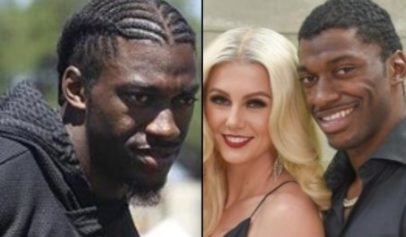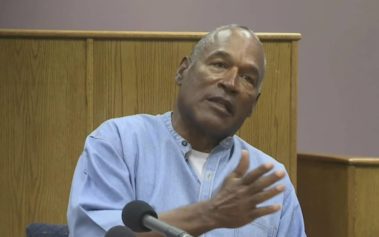Robert Griffin III brings the ideal pedigree to the Nation’s Capital’s beloved NFL franchise, the Washington Redskins. The Heisman Trophy winner is immensely talented, has an astute acumen to play the quarterback position and will get an opportunity to play from the start.
In Chocolate City, an African-American quarterback as the face of the franchise is a marketing bonanza. That he is affable, smart and grounded should prevent him from alienating fans that do not look like him; they should embrace the redeeming elements of his character.
And yet, even with all that going for him, he still might fail in D.C., where potential stars come crashing down with head-spinning regularity, be it in sports or politics. This is not to dampen the excitement this first-rate athlete and, by most credible accounts, fine young man brings to a fan base famished for someone to cheer, something to embrace.
This is to point out that there are dynamics beyond his control as an African-American quarterback in the NFL – even in today’s NFL – that could weigh in on his success. Like many young African Americans starting a new job, his success or failure is largely beyond his control.
First and foremost is that he will be playing under Mike Shanahan, once an offensive guru but more recently an offense to offenses. He traded away a promising young quarterback in Jason Campbell before he even knew his way around Redskins Park. That would not have been so bad if he had not replaced him with Donavan McNabb, who had played his best football about three years prior.
To compound turning the team over to McNabb, whose mobility had diminished as much as his accuracy, he offered disingenuous explanations for pulling McNabb with about two minutes left in a tight game for the appropriately named Rex Grossman.
Shanahan offered that it took stamina to run the two-minute drill, ludicrously suggesting that McNabb, a veteran who engineered several last-possession winning drives in his solid career, would pass out from exhaustion at that juncture of the game. (On the first play after pulling McNabb, Grossman fumbled and the Redskins did what they have done a lot of since Shanahan arrived; they lost.)
Eventually, the insulted McNabb was ushered out, and the starting quarterback job on a team trying to rebuild was left to Grossman, a retread quarterback of little renown. Oh, and there was someone named John Beck to back him up.
This comical-if-it-were-not-so-dreadful carousel amplifies Shanahan’s downward descent over the last dozen years. Since winning the second of consecutive Super Bowls with John Elway at the helm in 1998 with the Denver Broncos, his teams are an aggregate 12 games over .500: 102-90.
That’s pretty average.
Of course, football is a team sport and other elements of the game contribute to the outcomes. But for someone who arrived with so much fanfare, Shanahan has overseen offenses that have been progressively unproductive over the years. Worse, they have been unimaginative.
Which leads us back to Griffin. During his spectacular Heisman Trophy-winning season, he displayed an ability to make all the throws out of the pocket and to make impromptu plays using his sprinter’s speed and agility.
Will Shanahan conform to Griffin’s skill set or will he try to force this bustling talent into a confining bubble? That’s how success can be hard to achieve for Griffin – he might have to overcome the coach and the opposition. From afar it seems Shanahan is an egomaniac that believes more in his system than he does in developing schemes around the talent at hand.
And so, will Griffin receive the benefit of the doubt and the patience necessary to build gradual success into superstar status, the way Elway and Peyton Manning did? This is a question because Shanahan used a fourth-round draft choice on another quarterback—Michigan State’s Kirk Cousins, a fine player who is far less dynamic than Griffin, but far more suited for Shanahan’s “West Coast offense” built on short passes.
For a team in dire need of help in most every areas to use such a high pick on another QB signals more than adding depth at the position. It may be the harbinger of doom for RG III. Finding a backup quarterback is not that difficult. But developing two young players at that position at the same time is virtually impossible.
How can Cousins progress holding a clipboard on the sideline? How can Griffin feel comfortable knowing so much love has been extended to Cousins? How long before there are cries for Griffin to be benched for Cousins when Griffin struggles, as he is bound to as a rookie in the NFL? If Griffin is your guy as the No. 2 pick in the draft, why create the potential for controversy? Why not use that fourth-round pick to build help around Griffin, some offensive line protection or viable receivers?
The questions are virtually limitless, including that of race. It is hard to ignore the differences between Griffin’s and Cousins’ skin complexion. Cam Newton, an African-American No. 1 pick in the 2011 NFL Draft, arrived at Carolina last year and had an offense built around him. He had no potential controversy with a backup quarterback. He was assured the team was his to lead and he was allowed to grow freely over the course the year.
Newton was set up to succeed, and he did. Not so much for Griffin, at least so far. Indeed, he very well could be set up to fail.
Curtis Bunn is a best-selling novelist and national award-winning sports journalist who has worked at The Washington Times, NY Newsday, The New York Daily News and The Atlanta Journal-Constitution.


